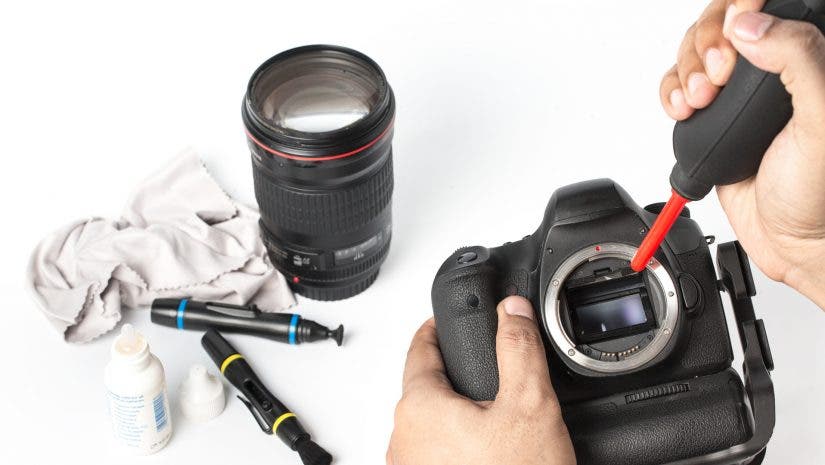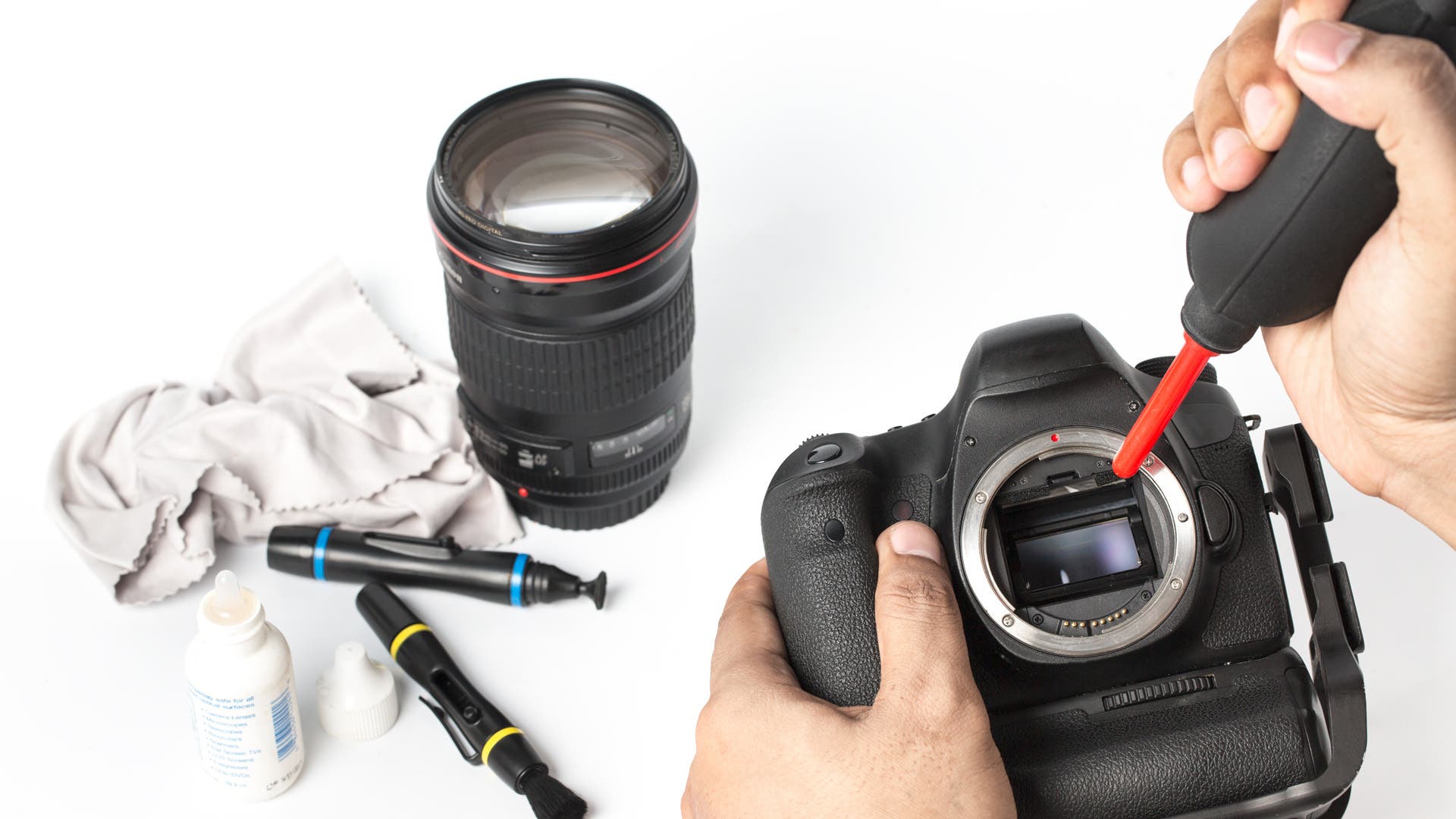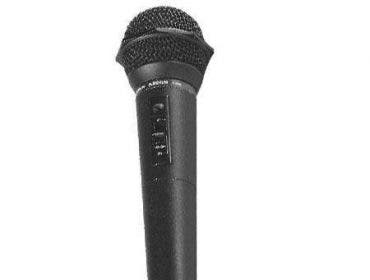Do you see mysterious dark spots on your DSLR images?
If the answer is no, ignore the rest of this article and be happy. But if you have seen these spots, read on. Your DSLR probably has dust on its sensor–a normal, but inconvenient, fact of life when using digital cameras with interchangeable lenses. Removing this dust from your sensor requires a delicate touch.
I’ll show you how.


A tough spot: 100% enlargement of highlighted area in above image at right reveals two spots caused by dust on a DSLR’s sensor. It’s a common problem, and fixing it yourself comes with risks…unless you do it right. (Photo: Mason Resnick)
Where did those spots come from?
Spots on a digital image are sometimes attributed by users to dirt on the lens or SLR mirror, but this is almost never the case. The mirror is out of the optical path when an image is made, so even large amounts of dirt on the mirror will not show up in the image. Dirt on the lens elements will also very rarely show up as spots on the image since it’s so far out of focus. You might see dirt on the front element of a fisheye lens if it’s set to its minimum focus distance and stopped down, but the optics of normal lenses won’t produce images of dust particles inside the lens.
Dirt can potentially enter your camera whenever you change lenses. That’s why this isn’t a problem with digital cameras with built-in lenses. One way to minimize dirt is to point the camera down while changing lenses. It won’t stop all dirt, but it may minimize spots.
Check your sensor
If you don’t know if your sensor has dust, here is how to check. Put a lens on your camera, set focus to infinity, exposure compensation to +1, and the aperture to its smallest value (largest number)–at least f/22, f/32 if you have it. Hold the camera a foot or two in front a uniformly illuminated target that fills the frame and shoot. Exposure may be several seconds, but that’s OK. You don’t need to hold the camera particularly steady. You want the exposure to be uniform, which is why you’ve deliberately defocused, so camera motion will make no difference. Look at the image. Do you see dark spots? If so it’s 99% certain you have dust on the sensor.
At wider apertures, the dust specs will be much less visible. At f/11 they may be very faint and at f/8 or wider apertures they may be undetectable. If the aperture setting doesn’t affect the appearance of the spots, and they are very sharp and well-defined, they are more likely to be sensor defects than dust.
Can you spot spots?
Below are three 100% crops from a test image. On the left is a portion of the original image, which was shot at f/5.6. It’s very, very hard to see any evidence of a dust spot. In the center is the same shot, but with an extreme histogram stretch to bring out the very low contrast detail. You can now see a large circular area that’s somewhat darker the background. That’s the shadow of the dust spot on the sensor. Finally on the right is a crop from exactly the same position in a test frame shot at f/32. The dust spot is quite obvious without any manipulation of the image.

Some cameras take some pains to remove dust from the sensor by rapidly vibrating, “shaking”the dust off the surface. By all accounts, this system works pretty well, but it doesn’t help owners of cameras that lack this feature. And it isn’t foolproof!
If you see dust on your sensor (and eventually, everybody will) you really then have only three choices:
- Ignore the dust spots and clone them out if and when you see them. This will get very tedious and time-consuming, so it’s really not a very good option if the spots are visible under normal conditions. If you only see them at f/32 after increasing the image contrast then you can probably live with them. All sensors will show some dust if you look closely enough.
- Send the camera back to the manufacturer or your favorite repair shop for cleaning. It will probably cost you at least $50 and you may be without your camera for 2-3 weeks, but there’s a good chance it will come back dust free. There’s also a chance it will come back with less dust, but still a few specs. Even if it does come back clean it will probably pick up dust with a few weeks of use. Then what do you do?
- Clean it yourself. This would be the obvious choice if it were not for a very small chance you could do some damage and end up with a $200 repair bill. Many, many people have cleaned their sensors themselves without any problems, but if you are clumsy, you don’t use the right cleaning tools or are just very unlucky, there is small chance you could have problems.
Why I vote for option three
Since even after you (or someone else) has cleaned your sensor it will eventually get dirty again, learning how to clean it yourself will save you a lot of time, money and frustration in the long run.

The surface of the sensor (see the diagram at right, which shows the construction of the Canon EOS D60’s sensor) is about as delicate as the surface of a multi-coated filter. In fact, it is pretty much the surface of a multicoated filter since the actual sensor itself sits behind anti-aliasing and IR blocking filters in almost all DSLRs. If you can clean a multicoated filter without damaging it, you can probably clean a digital sensor surface. The only caveat here is that even the smallest scratch will show up on the sensor while a small scratch on the filter may go unnoticed.
Technical note: The dust isn’t actually on the sensor surface. It’s on the surface of a filter which is in front of the actual sensor itself. This is why dust shows up more at smaller apertures. Since the dust spots are some distance from the actual sensor pixels, a wide aperture lets in light which can “go around” the dust spot. It’s a bit like using a large softbox for lighting. Shadows (and what shows up in the image is the shadow of the dust spot) are light and soft. At small apertures it’s like using a small pinpoint spotlight and shadows are dark and hard edged.
The following images show small dust spots as f/22 and f/11. They are almost invisible at f11 and only very faintly visible at f/22

Here’s what very dusty sensor looks like at f/29. This is a 100% crop from an original image, no processing applied. After cleaning no dark spots could be seen.

Here are several ways to try to remove dust from the surface of a digital sensor.
All require first raising the DLSR mirror and opening the camera’s shutter. Most DLSRs have a Cleaning mode which does both of these things, leaving the sensor visible if you remove the lens from the camera.
Method 1 – The Blower
This is the safest way of trying to clean a sensor, though it’s probably also the least effective. Canon, for example, recommends a blower bulb, with the tip of the bulb, held no further into the camera than the lens mount. The theory is that with bursts of air you can blow the dust off the sensor. What you may actually do is redistribute the dust inside the camera. If there’s more dust on the sensor than around it, you’ll may end up with less dust on the sensor. However, my attempts at this method usually resulted in more dust on the sensor than I started out with!
- Good points: Zero possibility of the damaging sensor. Even if the shutter should close you’re OK if you’re outside the body with the blower. Easy to do, so it’s always worth a try.
- Bad points: Doesn’t seem to work very well; may result in more dust than you started out with.
Caution: Do not use any sort of “canned air” for this. It may be too powerful and the types that are liquid driven can “spit” liquid in the gas stream and if that happens you may find residue left on the sensor.
Method 2 – The Brush
If you can’t blow the dust off the sensor surface, maybe you can brush it off. The brush actually picks the dust up and removes it from the camera, rather than just dislodging it and having it land somewhere else inside the camera body.

A company called Visible Dust introduced a line of very high-tech brushes which have bristles made of specially-shaped materials and are treated in a high-tech way (in a plasma chamber), producing a brush that won’t damage the sensor but will attract dust onto the bristles rather than just pushing it around on the sensor. From all accounts, the Visible Dust brushes do a very good job of sensor cleaning,though they are not inexpensive.
- Good points – Usually works, very little chance of doing any damage
- Bad points – Commercial brushes aren’t cheap, but they’re cheaper than a new sensor and cheaper than having a professional clean the sensor a few times.
The Brush technique–DIY version
The research scientist in me wondered if I could get away with using a cheaper brush. The basics of a desirable brush are that it should use fine, soft, synthetic fiber bristles and the handle should be insulating. This will, in theory, enable the brush to hold a small electrostatic charge which will attract dust and”vacuum” it off the surface of the sensor as the brush passes over it.
![]()
I found a very inexpensive makeup brush at Wal-Mart (shown). I don’t remember what it cost. Probably less than $1.
The most important property of the brush isn’t that it removes dust, but that it doesn’t mark the sensor. The brush has to be clean and free from grease and oil. You can wash it with a mild detergent and thoroughly rinse it with clean water, then test it by brushing it over a clean multicoated filter a number of times. If you see any marks left, it’s not clean enough to be used on a sensor. You can put a small static charge on the brush by blowing air through the bristles (which also should blow out any trapped dust) using either a blower bulb or compressed gas. The small static charge attracts and holds dust particles without risking sensor damage.
For me, this brush worked quite well in removing the dust on my sensor as shown by the series of images above. Since the brush is only about 1cm wide it took a couple of passes to go over the whole sensor. Sometimes it’s necessary to do a 3rd or 4th pass to remove all the problem dust particles. The Visible Dust brush is wider and can clean the sensor in a single pass.
Is it better than a Visible Dust brush? Probably not. Is it safer? I don’t think so, in fact, it’s probably riskier. Is it cheaper? Yes, it is. Could it damage the sensor? I can’t say for sure it won’t, but it hasn’t yet.
Method 3 – If all else fails…full contact
If the dust refuses to move with either a blower or a brush, somewhat more drastic measure may be called for. You may have to make harder physical contact with the sensor surface with some sort of cleaning device. Since this method has the most physical contact with the sensor, it’s the most effective at removing stubbornly attached dust or dirt–but it also has the highest chance of damaging (scratching) the surface of the sensor assembly.

The first method of removing stubborn individual dust specs is to use a SpecGrabber, made by Kinetronics. This is an insulating plastic rod with a small pad on the end. The pad provides a high adhesion surface for individual dust specs, higher than the force holding them to the sensor surface (if you’re lucky!), so it will lift the dust off the sensor. The pad leaves no residue and uses no solvent. It can be washed and reused. The only trick here is finding the individual dust specs! They are usually too small to be seen with the naked eye, and the tip of the SpecGrabber is only a few mm in diameter, so you may have to hunt around for them, checking the sensor each time to see if you’ve got them.

The second full-contact method is to use a lens tissue in conjunction with a solvent cleaning fluid. This will clean the whole sensor at once so for a sensor with a lot of dust will be faster and easier than trying to remove each with a device like the SpecGrabber. You can make your own tools to do this, or you can buy them.
To make your own what you need is a soft but fairly rigid support, about 15mm wide by a few inches long and 1-2mm thick. This could be a Popsicle stick, a modified plastic knife, a modified kitchen spatula, or a strip cut from an old credit card. The idea of a soft but rigid support is that if you should turn out to be physically inept and instead of wiping the tissue across the sensor you tear the tissue and/or scrape the support across the sensor, you’d rather it was soft like plastic than hard like steel. You then take a sheet of lens tissue, fold it lengthways several times until it’s about 15mm wide, then fold it in half and place it over the stick as shown in the figure below. 15mm is the approximate height of an APS-C digital sensor.
Do not touch the tissue in the area which will contact the sensor. Not only will you transfer grease onto it from your fingers, you may transfer dust and grit. Running a greasy, dusty, gritty tissue across the face of the sensor is not recommended.

You then moisten the end of the “swab” with pure methanol or other high-quality, no-residue cleaning fluid such as that made for cleaning multicoated optics. Do not use Windex or any similar household cleaning fluid! The key here is “moisten”. You don’t want liquid dripping off. It should be wet, but not that wet.
Hold your breath, engage the sensor cleaning mode on your camera to expose the sensor and gently wipe the swap across the sensor from one side to the other. The idea is to contact the whole width (height) of the sensor as you wipe across it from edge to edge. If you have to do it again you will use another clean sheet. “Clean” is important word here. Don’t try to economize by using the same tissue twice.
You don’t need to scrub the sensor or apply too much pressure, but you do want to apply enough pressure that the tissue fully contacts the sensor surface. The trick is that you don’t know how much pressure this is until you’ve done it. Perhaps a couple of practice swipes across a filter might give you a better feel for what’s required. Obviously, you use a fresh piece of lens tissue before cleaning the sensor.
Now, do another dust test by taking a shot of a uniform bright surface with your lens stopped down to f/22 or smaller. If you are lucky you will see very few (if any) dust spots. If you are unlucky you will still see multiple dust spots.
If you see some dust left (and you don’t see any damage!) you can repeat the process and hope to remove it. However, the trick here is not to push things too far. Removing every last tiny spec of dust that’s visible at f/32 is not necessary. Even if you do manage to do it, within a day or two I’ll bet you’ll find a few small dust specs back on the sensor. You do not want to clean the sensor any more frequently or vigorously than absolutely necessary. The less contact you have with the sensor, the lower the risk of doing any damage.

You can buy special cleaning swabs for this purpose such as those sold under the name Sensor Swabs made by Photographic Solutions Inc. They are assembled in a clean room and sealed. The chance that they will scratch the sensor is very, very, very, very, very low (unless you get dirt on them yourself after you unwrap them). The downside is that they are $4 each and sold in packs of 12, so they will cost you $48. However, this is much less than the cost of replacing a scratched sensor. You can also buy special cleaning fluid (such as Visible Dust Smear Away Solution Kit, Tough Sensor-Stain Remover (shown), which costs around $20 and will not damage the sensor or leave residue.
Lens tissue is much cheaper (about $2 for 50 sheets of Lens Tissue). You want optical grade lens tissue. I’ve used lens tissue on lenses for years without a problem, including cleaning some pretty delicate optics such as dielectric laser mirrors, so I’d say the chances of a problem are very, very small, but they are never zero. I’ve also cleaned my DSLR sensor maybe a dozen times with them, again with no problems.
Note: Be sure you buy untreated lens tissue, not silicone impregnated lens tissue sold in eyeglass stores. If you smear silicone oil on your sensor you will not be happy and you’ll be spending quite a bit of time trying to clean it off.
Caution and Disclaimer
While many people have reported success in cleaning their sensors using these techniques, I have seen one report of someone who scratched their sensor trying to clean it using a tissue. They probably weren’t working in a clean environment and picked up a tiny spec of grit on the tissue and they may have used too much pressure on the sensor. If you don’t have good mechanical skills and a delicate touch you might want to think a few times about whether you really want to do it yourself.A scratched sensor isn’t a total disaster, but replacing the sensor (or more likely the covering filter) will probably cost around $200-$300.







